







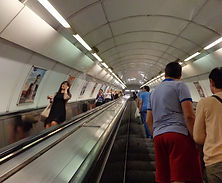




The next morning, after we enjoyed again the nice breakfast, maybe the best of the whole journey, we went to the hotel’s parking lot and we started the preparations for the trip. We checked again the rear tire of the bike, put our stuff on the motorcycles and at 8 a.m. we were already on the way, heading towards Prague.
The sky was deep blue but on the horizon you could see the dark clouds waiting for us, loaded with rain. The road till the borders was good. But after that, we entered a never-ending hardship. There were road works everywhere!! The 3 traffic lanes became 1 for many kilometers. The trucks made a big line in front of us. We were impressed to see that wherever the road got wider and we were changing lines to the right in order to let the faster drivers to pass, they were using the “alarm” signals in order to thank us for our kind attitude. Well…Europeans... Different mentality than ours… lets hope one day we adopt the same attitude.
The road surface started getting worse. These were the worst kilometers that we had to travel during the whole journey. Imagine that in the middle of the highway were 2,5 length ‘’frames’’ made by cement and filled with asphalt, which were put higher than the rest of the road, and all that for at least 20 km. The bikes were literally dancing and the suspensions were put into a serious test.
We stopped twice for refueling. As everywhere around Europe, the driver of the vehicle helps himself and then he pays inside the store. As in the Greek national highway stations, but much more organized.
It started to rain and by the time we put the waterproof clothing it stopped, it seemed like it was playing hide and seek with us.
We arrived at the hotel, which was right on the ring road of the city, before 5 o’clock.
It was a huge building full of glass, and it seemed to reflect playfully the last sun beams.
We parked our beloved ones at the underground parking lot and we went upstairs to our rooms. Because of the glass manufacturing the windows could not be opened, so we felt like being trapped in a luxurious cage. We had decided when we were planning the trip, not to take a lot of clothes with us, so we had to give them to the cleaner’s and after that we went out to the town.

In a (real) 10 mins walking distance was the metro station, which would take us to the center of Prague. We were smiling and with the map in our hands we went there without knowing what we had to face!!
There were ticket printing machines but did not accept cash card, we did not have any foreign money yet so we went to exchange some from an ATM machine. Coming back to buy our tickets, we noticed that the machine was not giving any change back so we went out the metro station to get some coins and after a lot of walking and searching we managed it at a pizzeria so we could buy our tickets. But the instructions on the ticket machines were unclear.
So, after some time of thinking we decided to press the choice of buying a 6-route ticket, since we were 3 of us. We thought it’s ok so we got into the train. It was old but in a good condition and clean inside the compartments. We stopped at museum station in order to take another line, which was going to the city center. By the end of the stairs there were 2 Metro ticket controllers waiting to check our tickets, with a frozen smile on their face. They told us that the ticket that we had was for use by 1 person for 6 times and it cost much more than the ones we supposed to buy! Furthermore, they told us in poor English that we had to pay a fine of 800 crowns each and every one of us! After some negotiations and a lot of irritation we managed to pay the fine for one person and we bought the right tickets this time.
But our smile had long gone and our good mood too, and so we headed to the old town.

Our first destination was to walk to the old town, the heart of Prague. In 1901 it is mentioned for the first time that a market was there, where now is the Staromestske namesti square in the Old town.
A big part of the history of Prague is reflected on the buildings around that square. On the north side the white façade of the baroque style church of saint Nicholas dominates, while on the east there are two magnificent examples of architecture, the Palace of the Stone Bell, a restored gothic palace and the Rococo Palace Golts-Kinksy.
The semicircle completes a series of buildings with facades in soft colors. A series of colorful romantic or Gothic style houses with impressive emblems, adorns the south side of the Old Town. Particularly impressive is the square between Seletna and Tseletsna road. The square has always been a central part of the city.
Today you can find here a tourist information center as well as many restaurants, cafes, shops and galleries.
ΤWe were gazing at the astrological clock that dominates the old Town Hall. This clock is worldwide famous about its history... The first clock was placed in the town hall in the early 15th century. In 1490 it was built again by a watchmaker named Hanous. Since then the clock has been repaired several times, but the mechanism that operates till now was perfected by Jan Tamporski between 1552 and 1572.

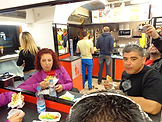



The main reason why thousands of people come every day to visit the clock tower is the parade of the 12 Apostles. At first, the form of death, made to look like a skeleton on the right side of the clock, pulls the rope which is holding in his right hand. In his left hand, he holds an hourglass, which rises and turns over. Then two windows open and the 12 Apostles move slowly, forming a circle headed by Saint Peter.
At the end of this demonstration, you hear a rooster and the clock announces the time. The rest of the mechanical figures is a Turk who shakes his head from side to side, Vanity looking in a mirror, and Greed, which is presented on the medieval cliché as a Jewish usurer.
The concept of the watchmaker was that in the center of the universe is the Earth. The purpose of the clock was not to tell the exact time, but to imitate the supposed orbits of the Sun and Moon around Earth. The Sun index, which shows the time, actually records three different kinds of time. The outer ring, with the medieval Arabic figures, shows the "old Bohemian time," when the 24 hours’ day began to run from the sunset.
The ring with the Roman numbers show the time as we know it. The blue part of the plate represents the visible part of the sky. This is divided into 12 sections. In the so-called Babylon period, the day was divided into 12 hours of variable length, depending on whether it was summer or winter. The clock also shows the movement of the Sun and Moon at the 12 zodiac signs, which played an important role in the life of Prague in the 16th century. It is said that when the watchmaker finished this work Charles took out his eyeballs in order not to be able to rebuild it for another King!
After admiring and videotaping this wonderful artwork we walked up the famous Charles Bridge. The most famous monument of Prague, (which now is full of street vendors’ benches), connects the Old City with the Small Part. Before getting paved, four carriages simultaneously could pass from here. Today, many of the statues of the bridge are copies. The original ones are kept in Lapintarioum and in the National Museum.
The Gothic Tower Bridge of Old Town is one of the finest buildings of its kind. The Charles Bridge has often suffered floods and other natural or human disasters. Nevertheless, it still stands and will remain a symbol of Prague for many years to come. It is said that yolks of eggs have been used to strengthen the joins of the stones.
All these masterpieces were nice, but our belly was protesting from hunger, so we started looking for somewhere to eat before the protest turns into a riot inside us!!! This time we did not want to eat at a gourmet restaurant so we went to one of the gyro places. The souvlaki tasted really nice, it really helped us on the fight against our hunger!!
But it also calmed down our tired bodies and drugged our minds, giving the command to go to sleep... the spirit indeed was willing to walk back to the metro but the flesh was weak, so we looked for a taxi to take us to the hotel. It was almost midnight, but still there was a lot of traffic , so on one moment we went with 90km, and the other the taxi had to drive with 40 km.!! All the cars had to follow the speed limits!!! All of them!!! We asked the driver what was going on and he told us that because of some roadworks there was a maximum speed limit of 40 km and there are speed cameras that give tickets ...
Impressed by the discipline we compared that with what happens in Greece ....With the only difference that usually we put a poor guy with a phosphorus flag shaking it back and forth, with the risk of his life, in order to warn the drivers to speed down due to roadworks. It is exactly the same. Hee-hee.

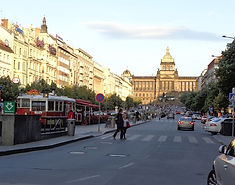



The next morning, the day seemed to be lovely, and we started going to the castles. We bought the right tickets this time and we took the metro, so we arrived to the castles entrance. From there we walked through the stone made street to go up to the castle. As we were walking to a higher point the view was astonishing. The city of Prague was lying in front of us and we could not believe how beautiful it was…the yellowish colors of the buildings in combination with the decorated rooftops, it was like we went back in another era, older and more romantic.



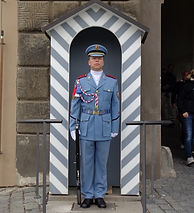

Reverently we watched the change of the guards at the castles entrance and admired their perfect synchronization!!! Following the tired soldiers, we walked into the Prague’s Castle which is a cluster of buildings at the top of a large hill on the left bank of the Vltava River. The area of the Prague’s Castle is called Chratsani. It is not exactly a classic castle, because several parts were built in different styles and the castle was extended more horizontally than vertically.
We bought the tickets for the most important sights and we entered the "Golden Alley" which is a series of small colorful shops that originally served to house the guards of the palace. This narrow, small road, one of the most picturesque of Prague, was named after Prague’s goldsmiths who lived here during the 17th century. On one side, there are beautiful houses built into the arches of the castle walls, made by Rudolf II to house the 24 guards of the castle. One hundred years later the goldsmiths moved there. In the Gold Alley lived several known writers such as Saifert and Franz Kafka.


A little further from the Golden Alley we saw the Daliborka Tower, named after one aristocrat who was imprisoned there on suspicion of complicity in a peasant rebellion. The torture rooms literally infuriated us, because their components were so excruciatingly painful that only by seeing them you could feel the pain they were meant to make!!! I cannot hide from you the fact that at some point I was tempted to try the tools on one specific person, but I would have many witnesses and so I had to postpone it!!!





So, leaving our bad thoughts behind, we continued our tour to the church of St. Vitus. Construction work on this cathedral, the most important landmark of Prague, started in 1344 by order of Charles IV. The first architect of St Vitus was the Frenchman Matthias of Arras. After his death, the head of the project was taken by the Swedish Peter Parler and was completed by architects and painters of the 19th and 20th century. By walking to the Cathedral of St. Vitus we faced the history of thousands of years. We entered the west entrance and saw some of the best pieces of modern, neo-Gothic style. Then we went through chapels and admired religious objects such as relics of saints and works of art from Renaissance paintings to modern statues. We spent plenty of time admiring the Chapel of St. Venkeslaoun, which is decorated with gemstones.
The cathedral has some impressive stained glass of the 20th century, among which stands out the work of Czech painter Arnouvo Alphonse Mucha (1860-1939), on the Apostles of the Slavs from Thessaloniki "Saints Cyril and Methodius" (1930).
The daylight and the hidden rays of the sun emphasized the wonderful colors of the stained glass, conjuring before us the figures on them. In front of the Mausoleum is located the marble main altar of the church with a royal crypt, where Bohemian kings were buried.
The royal crypt just below the cathedral consists of the tombs of Charles IV, of his four women, and also some other royal persons.
Of particular importance, is also the tomb of St. John, which dominates on the left side of the temple, made with 3.600lbr of silver, showing the importance of the Saint. It is believed that Charles, since the saint did not reveal what his wife was confessing to him, a cold winter night tried to throw him into the river Vltava, thinking that they would not see him. But once the saint fell into the river 5 stars from the sky lit up the scene so everybody could see the evil action their king did. That is why they picture him with a halo of 5 stars. Externally the church is filled with statues decorating the gutters. Very strange figures reminiscent of fairytale with dragons and elves.






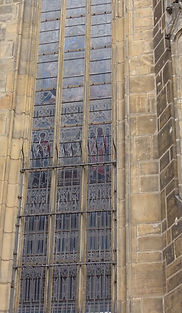

Amazed and also tired by the long tour, we sat in a café located in the courtyard. There we enjoyed our drinks, one had a hot chocolate, another a hot wine and the third of the group had (what else??!!) the traditional fredoespressoalaPanos . A coffee made by Panos, which is like the coffee fredo espresso that we have in Greece, since unfortunately the only coffee they knew there was boiled water with some coffee and ice cream!!
We left the castle and walked downhill to the old town, passing again from the suffocating crowded Charles Bridge. We made our wish at the point where Charles threw St. John, as the locals say that if it truly comes from your soul then it comes true.




It was already noon and we decided to eat at a local fast food restaurant located on Wenceslas Square, a boulevard with a length of 750 and width 60 meters. The plans for making the square began to take place over 600 years ago, in the time of Charles D. when the site was used as a place for buying and selling horses. Since then, the square is a place for parades of all kinds of people, for organizations or political parties in the Czech Republic. The avenue leading to here is so big that can easily fit as many as 400,000 people. At the top of the avenue you will see the statue of St. Wenceslas riding his horse.
Today, the Wenceslas Square is the bustling center of commerce which really comes alive after dark when its restaurants, cinemas and nightclubs attract crowds of tourists. So, there are many canteens adorned with some huge sausages of all kinds of tastes, even chicken sausages!!!! We ordered three with spices and chicken on a soft bread ... we put a lot of ketchup, mustard and mayonnaise, adding also some boiled cabbage or onion
The smell of the baked sausages got into our noses, we could not say though that the taste was what we expected but overall it was good ..





In order to digest we needed to take a walk to the shops to buy souvenirs and gifts.
But after some walking we felt the appetite for something sweet, and as we were thinking what that would be, a soft breeze with a flavor of cinnamon and burned sugar made us follow our noses and we arrived to a kiosk which was making the traditional rakvicka desert. You could eat it as it was, or you could put some extra sugar or marmalade. But we…typical Greeks... chose hazelnut praline!
Our senses had already surrender to this fabulous taste! You could just close your eyes and enjoy the taste of the burned sugar along with the taste of cinnamon and hazelnut praline, waking up all of your senses!
After that sweet orgasm, we had to have a coffee.
We went back to the square where we decided to visit the Old Town Hall before having a coffee. It is one of the most impressive buildings of Prague founded in 1338, when King John of Luxembourg gave permission to create a council.
Over the centuries, several old houses joined together, that’s why, the Town Hall consists of a series of Gothic and Renaissance buildings, most of which have been renovated after the damage suffered by the Nazis during the uprising in Prague in 1945.
Very interesting is the fact that the place which looks newer is actually the oldest. The tower of City Hall, height 69.5 meters, was built in between the 14th and the 15th century and was given a neo-Gothic form. Today it is open to tourists and offers a unique view of the city. The photos speak for themselves.


We finally sat at the cafe next to the clock watching for one last time the performance of the 12 Apostles exiting as the clock rings, drinking our coffee which again didn’t taste like coffee….
The time was already 6pm. We had to go back to the hotel to prepare our things since we were leaving the next morning for Karlovy Vary
But an overnight, heavy food poisoning with vomiting, transient high fever, convulsions and stomach disorders did not let the poor traveler’s bodies to rest!!
The next morning, visibly exhausted and after drinking only one cup of chamomile to take our pills, without much enough power and appetite, we put our stuff on the bikes. We went out to the district and took the road to Karlovy Vary. The beautiful spa town is located in western Czech Republic close to the German borders, 140 km from Prague. It was founded by Emperor Charles IV, in the 14th century.
A police patrol car accompanied us discreetly until we got out of Prague






The route was wonderful. The variety of colors with the shades of green inside the fields next to us, gave a different touch to our trip. Gradually we got back our good mood and with the nice weather on our side we arrived before noon at our destination. The traditional hotel owners were very hospitable but did not speak English. However, with some English, some German and some Italian words ... we managed to communicate..
We left our stuff at the hotel and we got our cameras to go downtown. The place is literally drowned in the forests of the valley of the small river Tepla and it is famous for its 12 thermal mineral springs. Over the centuries, it became known throughout Europe as a meeting place of writers, artists and politicians.
Crossing the main pedestrian street near the Tepla River, we understand why the Tsar Peter the Great, Goethe, Liszt, Beethoven, Bach, Chopin, walked the same road. The colorful houses were competing with each other in beauty and the fragrance of the surrounding nature made you open the windows of the mind and fill its hallways with all these images which looked like a painting.

We went through the hotel where the 007 movie Casino Royal was filmed. It is a white imposing building and we were imagining 007 chasing the bad guy in front of our eyes!

As our eyes were satisfied by the beauty of Karol’s health resort, we sat to eat in a traditional restaurant located right next on the downhill as you enter the city center. Although there was not much appetite after the food poisoning, we felt we should eat something in order our stomachs to cope with the medicines.
We looked at the huge portions that they served and were wondering how it would taste. Indeed, there are no words to describe it. The men of the company couldn’t eat it all as it was too much for us! Don’t think that the woman of the company ordered the same and ate it all… because of the food poisoning she preferred to order something light, she took a delicious local soup.
The price for the dinner was a real surprise, only 9 Euros per person! That was the cheapest and the most delicious dinner we had in the whole trip.
The next day was quite difficult as we had to travel a long distance, and because we felt exhausted we didn’t stay for the spa as we had planned. We preferred to go back to the hotel to rest and gain some strength...
Click on the photos to enlarge
Written by Bill Economou & Sotiria Bantouvaki
Translated by Bill Stavropoulos
Prague



